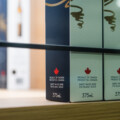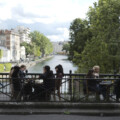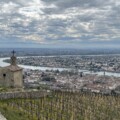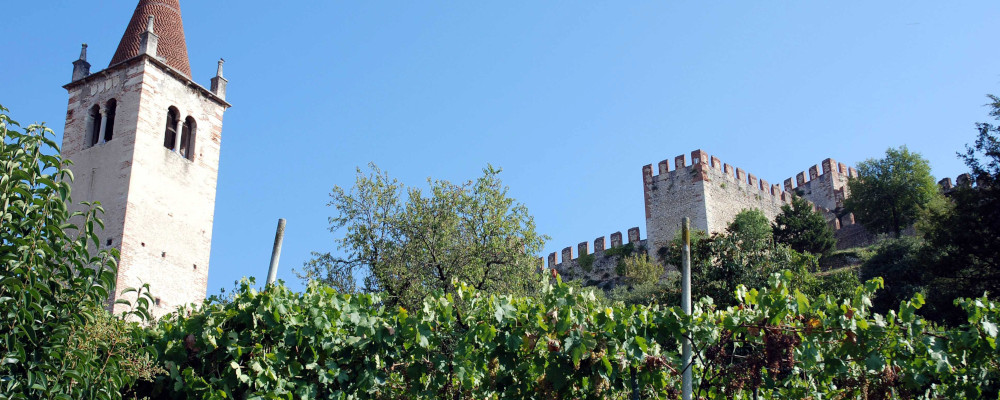For four of the last five vintages, Veneto, in the Northeast of Italy, has made more wine than any of the other regions of the country. During this time, wine made in the Venetian hinterlands has accounted for about 20 percent of the nation’s production. This is particularly impressive given there are commercial vineyards in every one of Italy’s 20 regions.
The bulk of that volume is derived from Veneto’s two big 21st-century wine industry winners: Pinot Grigio and Prosecco. In 2017, Veneto made 43 percent of the world’s Pinot Grigio, and for comparison, the next biggest producer was the United States at just 14 percent. Veneto makes all of the world’s Prosecco, as it is an EU-protected geographical appellation. Prosecco can only come from the Prosecco zone, and all of it is in Veneto.
Veneto’s other well-known wine success story is its big red from the western end of the region, Amarone. Amarone came around in the 1960s and 70s when temperature controls in the cellar meant that the sweet red wines made from dried-out grapes in the hills around Verona could be fermented longer in cold weather. Keeping yeast alive longer meant less sugar and more alcohol, and the powerful “wines of contemplation” became a popular category for domestic and export markets.
The success of the big Veneto three is a welcome addition to the wino ecosystem. Most Prosecco is uncomplicated and fun. It’s the best match to green olives, in my humble opinion, and adds bubbly festivity to a casual gathering.
Pinot Grigio has achieved the ultimate English-speaking wine world accolade: the name of the grape has become its own category, like Chardonnay and Sauvignon Blanc. Wine snobs complain that mass-produced Pinot Grigio doesn’t taste like anything, which is both true and false.
A decent, good-value Pinot Grigio will have a crisp citrus flavour. It might not have much else, but that’s OK. Lean and refreshing, big brand PG, is a kind of gateway drug to more interesting, mineral, and acid-driven white wines. In addition, it has the double positive attributes of being widely available and just fine to be had on its own in lieu of a cocktail.
Amarone is largely something of a monster of a wine, though it can be made in a surprisingly delicate and elegant way. The women winemakers Marinella Camerani of Corte Sant’Alda and Camilla Rossi Chauvenet at Massimago are masters of this modern style that is in balance and remarkably light and fruit-forward.
But the big Amarone wines have their place too. In Verona, closer to the mountains than the sea, they make an especially hearty meat ragu, and it’s hard not to believe that Amarone was invented specifically to pair with it.
It’s also true that big Amarone can be seen as an analog to Pinot Grigio, the wines are just fine on their own at the end of a meal, served as one would a Port to aid digestion. The Italians will often describe a wine that can be served without or after food as a vino da meditazione; a wine of contemplation to be sipped while staring at a fire or in deep conversation with a friend.
Still, the universe of Veneto wines is much bigger than those big three. Here are a few wines from the Venetian hinterland that make it across the ocean with some regularity, generally offer good value at a fair price, and are worthy of a try.
Soave
In the late 1960s, Soave was one of Italy’s leading wine exports. But Garganega grape, from which it is made, is particularly vigorous and overproduction, and a corresponding decline in quality, saw the wine slip from fashion into a near obscurity. Over the last two decades, crisp white Soave is experiencing a risorgimento as a mineral-driven, food-friendly wine.
The Soave region is concentrated over a number of Alpine foothills just east of Valpolicella and Verona. It takes its name from a spectacularly crenelated castle that was built in the 14th century and looks like it was taken out of a child’s storybook. The soil mix in Soave is either ancient volcanic or limestone and the wines have a particular vibrancy and freshness.
Top producers increasingly fetch high prices for their Soave, but there are many good value wines that come into the market for around $20.

Lugana
The not-very-big Lugana region is on the very western edge of Veneto and spills into Lombardy in the hills just south of Lake Garda. The white wines are made from the Turbiana or Trebbiano di Laguna grape, which is a distinct clone of the widely planted cultivar. Made with care, these wines will often show a character of saltiness, as well as rounded peach or stone fruit notes, and remind Italian wine enthusiasts of Verdicchio from the Marche.
Lake Garda is a popular vacation spot for Milanese and Germans, and the reputation and demand for Lugana wines is a bit of a blessing and a curse. It’s a blessing because increased demand has meant investment and dedication to quality. It’s a curse because it also means high prices. And yet there are Lugana wines that pass through Canadian markets for $20-25 that are worth a try.
Valpolicella
Before Amarone there was Valpolicella, or what is now labeled simply Valpolicella Classico, to distinguish it from red wines in the area that are made from dried grapes, or Ripasso, which is a wine that is soaked in the pressed skins of the Amarone grapes. Those two latter sales dominate production still, so the fresh Valpolicella wines fly mostly under the wine consumer radar.
This is the traditional wine made in the Alpine foothills surrounding Verona.
Like Soave, Valpolicella passed from fashion (despite a recommendation from Ernest Hemingway), but the fresh and lively red wine, made from chiefly the Corvina grape, is also making something of a comeback as consumer tastes pivot towards lower alcohol, fruit-forward, and more food-friendly wines, and prices have mostly not caught up.
Bardolino
Bardolino is Valpolicella’s lighter cousin, like Laguna, grown in the lower lands by Lake Garda. More red fruit and often made with short skin contact as a kind of heavy rosé. Fruity and fun, as a resort wine ought to be, though some producers make more serious, concentrated versions.
Recommended for You

Malcolm Jolley: The comfort of familiar favourites—or the fun of finding new wines?

Malcolm Jolley: An ‘Elbows Up’ wine project everyone can get behind

Malcolm Jolley: Need some summer wines? Look no further than the food-friendly, low-sugar sippers of the sunny Southern Rhône

Malcolm Jolley: Need a date-night drink? French Northern Rhône wines are worth the investment




